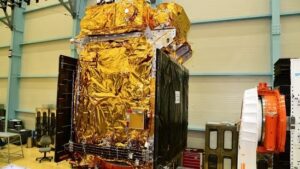India solar mission: The Indian Space Research Organisation (ISRO) stated on Saturday that the country’s first solar mission, Aditya-L1, will “possibly” launch on September 2 after successfully landing a lander on the moon’s unknown South Pole.
Aditya-L1 would be India’s first space-based observatory devoted to solar research.
“We had planned the ‘Aditya-L1’ mission to study the sun,” said Nilesh M Desai, a leading space scientist of ISRO and the director of Space Applications Centre (SAC), Ahmedabad. The mission is complete. There’s a chance the spacecraft will launch on September 2nd.”
His comments came only minutes after Prime Minister Narendra Modi delivered a speech to scientists at the ISRO’s Bengaluru headquarters.
The Indian Space Research Organisation (ISRO) declared on Monday that it had successfully landed a lander on the moon’s unknown South Pole.
Prime Minister Modi’s speech to scientists at ISRO’s Bengaluru command centre, he said, was “motivating.”
“Prime Minister Modi’s speech was extremely motivating.” His announcements will motivate us to plan and carry out similar missions in the future. His statements have given us renewed inspiration and passion to work for the country in the space domain,” Desai remarked.

I don’t have the words to convey how I felt about Prime Minister Modi’s speech. I can’t thank him enough for coming to see us right after he arrived in India. He claimed he couldn’t stop himself from paying us a visit. This was more than we could have hoped for. His announcements were intended not only to commemorate the success of our lunar landing mission, but also to help future generations remember the day and the accomplishment: Sudheer Kumar N, ISRO’s director of Capacity Building and Public Outreach (CBPO),
According to ISRO chairman S Somanth, the country’s first mission to study the sun will be ready for launch in the first week of September.
In recognition of the landing of Chandrayaan-3 on the moon, Prime Minister Narendra Modi declared August 23 to be “National Space Day.”
He declared that the ‘Shivshakti’ point would be called after the place where the ‘Vikram’ lander landed on the lunar surface, and that the ‘Tiranga’ point would be named after the impression made by the Chandrayaan-2 on the lunar surface.





